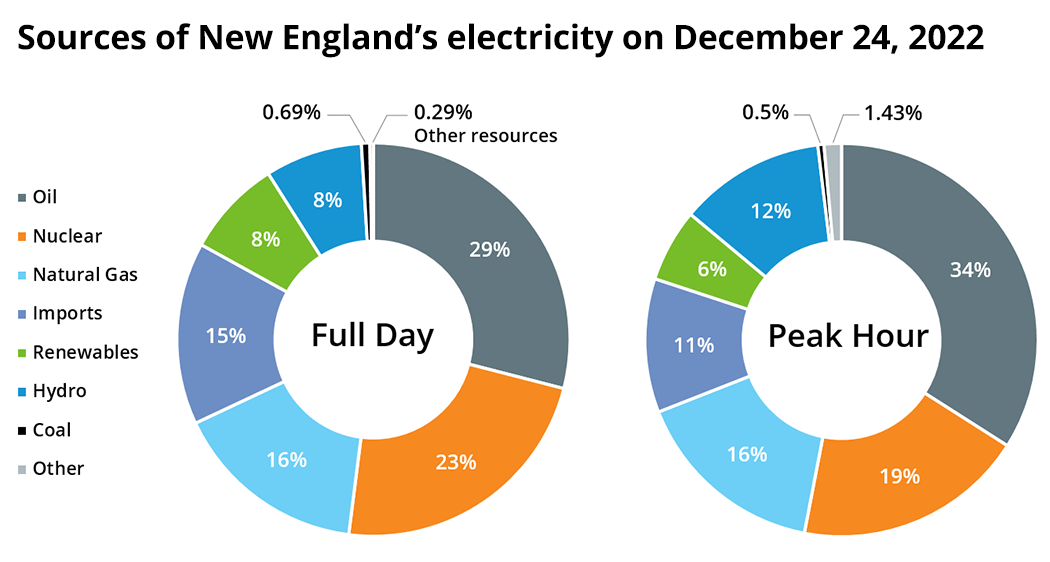ISO-NE maintains system reliability through generator outages, loss of imports on Christmas Eve
ISO New England system operators used steps from a well-established operating procedure to balance supply and demand on the regional power system during the evening peak hours of December 24, 2022, when unexpected generator outages and reductions and lower-than-expected imports led to a shortfall in operating reserves.
The ISO’s actions came during a period that saw challenges to the electric grid across North America, as extreme weather caused different issues to different power systems, including necessitating controlled power outages in parts of the United States.
The challenges in New England were not nearly as extreme, but did come on a long holiday weekend that saw a winter storm cause widespread outages to distribution systems in the region. Cold weather also led to oil generation being more economical than the gas-fired generation that typically provides most of the region’s electricity. ISO system operators were in close contact with neighboring regions, natural gas pipeline operators, and distribution utilities ahead of and throughout the operating day.
ISO New England did not call for controlled power outages on Christmas Eve, but did declare a capacity deficiency, meaning the region’s supply of electricity was insufficient to meet required operating reserves in addition to satisfying consumer demand, at 4:30 p.m. This action was taken after approximately 2,150 megawatts (MW) of resources scheduled to contribute power during the evening peak became unavailable. The outages and reductions coincided with net imports being approximately 100 MW less than had been expected based on that day’s Morning Report.
Per our information policy, ISO New England does not disclose operational details of individual resources. This policy is in place to ensure market participants provide the ISO with accurate and timely information regarding their resources without concern the information will be shared with their competitors.

System operators lean on established procedures
In response to the outages and reductions, ISO New England system operators used several measures under Operating Procedure No. 4, or OP-4, including using reserve resources to balance supply and demand and requesting conservation at market participants’ facilities. The capacity deficiency ended at 7 p.m.
Capacity deficiencies like the one that occurred on December 24 are different from the energy emergencies ISO New England warned about entering winter. Capacity deficiencies are typically short-duration events caused by the unexpected loss of resources and affecting the peak demand hours of the day. Energy emergencies, by contrast, would typically occur when a significant amount of resources lack the fuel to operate and produce electricity, and can affect all hours and last several days until resources are able to replenish their fuel supplies.
Pay-for-Performance rules apply
Following the ISO’s declaration of a capacity deficiency, a capacity scarcity condition was triggered between 4:40 and 6:05 p.m. Under the Forward Capacity Market’s Pay-for-Performance rules, resources that did not supply enough electricity or reserves to meet their capacity supply obligation are required to compensate the resources that made up the difference.
Underperforming resources will be penalized at a rate of $3,500 per megawatt-hour (MWh) for failing to meet their obligation during the capacity scarcity conditions, while resources that over-performed (including resources with no obligation) will receive $3,500/MWh of additional revenue. Penalties for the Christmas Eve event are estimated to be approximately $39 million, based on initial data. Charges for underperformance are paid by the underperforming resources, not electricity ratepayers.
Resources that cleared in the region’s Day-Ahead Energy Market, but failed to provide electricity in real-time are charged the real-time price for electricity during the period they fail to provide contracted power. Prices in the Real-Time Energy Market averaged approximately $484/MWh over the course of the day, with averages reaching more than $2,200/MWh during the 5 p.m. hour.

Colder weather increases mid-day demand, forecast accurate for peak
Temperatures across New England on December 24 were colder than initially forecast after an Arctic air mass moved further east than had been projected. This contributed to electricity demand being higher than forecast during the mid-day hours. The ISO’s peak demand forecast, however, was highly accurate, with a deviation of approximately 0.14%. Consumer demand for electricity peaked at 17,524 MW during the 5 p.m. hour.
Given the event’s relatively short duration and the ability of reserve resources to make up the deficiency, ISO New England did not call for public conservation.
- Categories
- Inside ISO New England
- Tags
- capacity, forward capacity market, oil, system demand, system operations, wholesale prices
